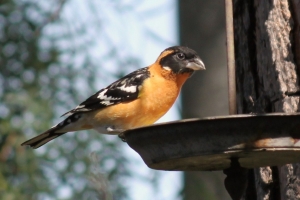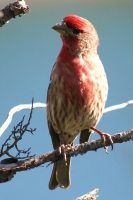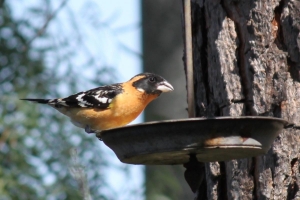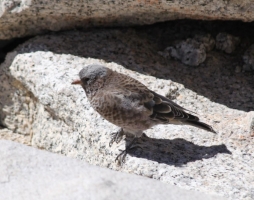
April 21, 2014 (San Diego’s East County) --There is a staggering estimated population of up to 1.4 billion House Finches across North America. If the birding scientific estimates are accurate, that would be about the same as the number of people in China today! When you consider that the House Finch was originally only in the western United States and Mexico until 1940, its success in population growth is even more impressive.
In 1940, a small number of finches were introduced as pets in New York. They came to the East Coast and particularly to Long Island, New York as “Hollywood finches.” This illegal finch pet trade did not work out and they were released into the wild so illicit dealers could avoid prosecution under the Migratory Bird Treaty Act of 1918. They easily adapted to their new environment, quickly started breeding, and are now common all along the East Coast and Northern Canada. The finch is now one of the most common birds in the inner cities throughout the continent.
 Being a common bird does not mean that it shouldn’t get the admiration of us who (including myself) sometimes take our local wildlife and fauna for granted. The House Finch, Purple Finch and Cassin’s Finch are three similar species that are sometimes referred to as the Red Finches. The males are showing off their bright red fronts this time of year. The red comes from pigments contained in their diet during molt. So, the more pigment in the food, the brighter red breasts in the males. Females prefer to mate with the reddest male they can find, possibly indicating a male with good food sources. I photographed this House Finch at Lake Murray on one of my walks. He was posing quit nicely showing off his red feathers!
Being a common bird does not mean that it shouldn’t get the admiration of us who (including myself) sometimes take our local wildlife and fauna for granted. The House Finch, Purple Finch and Cassin’s Finch are three similar species that are sometimes referred to as the Red Finches. The males are showing off their bright red fronts this time of year. The red comes from pigments contained in their diet during molt. So, the more pigment in the food, the brighter red breasts in the males. Females prefer to mate with the reddest male they can find, possibly indicating a male with good food sources. I photographed this House Finch at Lake Murray on one of my walks. He was posing quit nicely showing off his red feathers!
 The Finch family (Fringillidae) is quite large and includes Pine Siskin, Goldfinch, Red Crossbill and Evening Grosbeak to name a few. I’ve had the pleasure to have a Black-headed Grosbeak (pictured here - yellow-orange with black) come to my bird feeders now and then here in Alpine. This attractive bird is similar in looks and reminds me of the Evening Grosbeak, but is a different family then the finches, but is the same order (Passeriformes). Easily to confuse the two species of birds. The Black-headed Grosbeak has a large thick strong bill to snap through large seeds that other birds often have trouble with.
The Finch family (Fringillidae) is quite large and includes Pine Siskin, Goldfinch, Red Crossbill and Evening Grosbeak to name a few. I’ve had the pleasure to have a Black-headed Grosbeak (pictured here - yellow-orange with black) come to my bird feeders now and then here in Alpine. This attractive bird is similar in looks and reminds me of the Evening Grosbeak, but is a different family then the finches, but is the same order (Passeriformes). Easily to confuse the two species of birds. The Black-headed Grosbeak has a large thick strong bill to snap through large seeds that other birds often have trouble with.
Last but not least is my rarest Finch spotting. I spotted this finch last summer at an elevation of 14,505 feet! My son Kyle, brother-in-law Gabe and I climbed to the top of Mt. Whitney on a day hike last September. The top of Whitney looks like a barren planet from far far away. Past the tree line, the Blue Jays, Crows, and Mockingbirds were no longer seen. In fact, there was no life at all after we passed the tree line. So it was a shock to see a tiny bird hopping around at the very top of the summit! This finch was the only visible life form at the top of Whitney besides us and other human hikers. So after a few photos of us at the top of Whitney I started snapping photos of this bird. This is a Rosy Finch, a bird that breeds and nests above the tree line. And the Rosy Finch at the top of Mt. Whitney seem to have a lot more energy than we did. Of course, we had to hike and didn’t have the luxury of wings. The Finch family has some common birds in the group, but also has some uncommon family members as well. Enjoy the wonder and beauty of the outdoors.








Recent comments